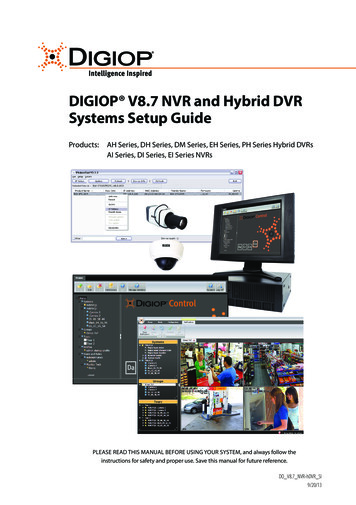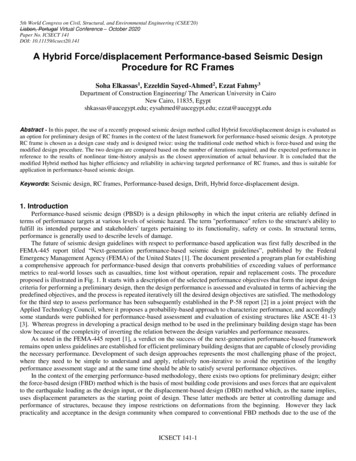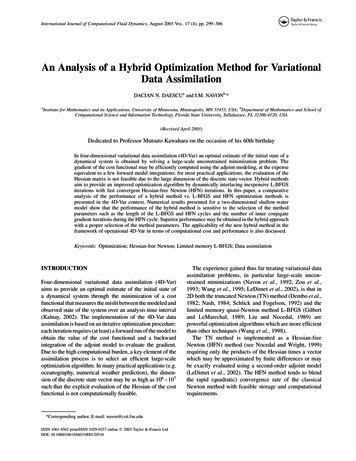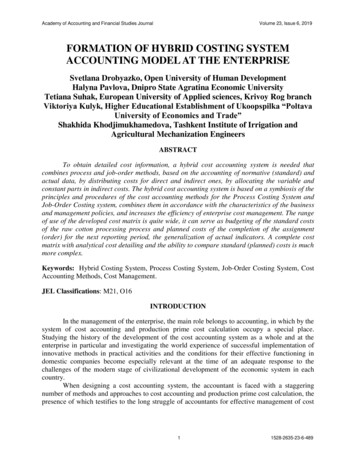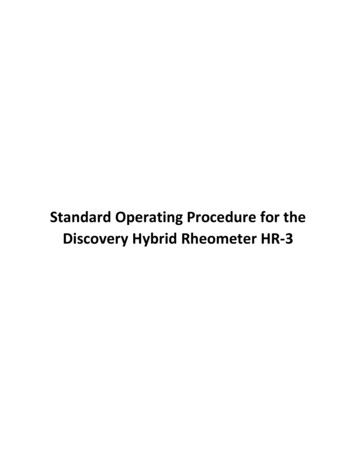
Transcription
THE COMPLETE GUIDE TOHYBRID LEARNINGINTRODUCING THENEXT GENERATION CLASSROOM
TABLE OF CONTENTSINTROWhy Should I Read the Complete Guideto Hybrid Learning? . . . . . . . . . . . . . . . . . . . . . . . . 3PART ONE: WHAT IS HYBRID LEARNING?Some Perspective. . . . . . . . . . . . . . . . . . . . . . . . . . 5Trends Driving Hybrid Learning. . . . . . . . . . . . . . 6PART TWO: BUSINESS CASE FOR HYBRIDLEARNINGBenefits to Participants, Instructors, Managers . .Four Core Benefits . . . . . . . . . . . . . . . . . . . . . . . . .ROI Research . . . . . . . . . . . . . . . . . . . . . . . . . . . . . .Case Study. . . . . . . . . . . . . . . . . . . . . . . . . . . . . . . .891011PART THREE: IS HYBRID LEARNING FOR YOU?Worksheet. . . . . . . . . . . . . . . . . . . . . . . . . . . . . . . . . 14Six Signs Infographic . . . . . . . . . . . . . . . . . . . . . . . 15PART FOUR: IMPLEMENTING HYBRID LEARNINGChoosing a Provider. . . . . . . . . . . . . . . . . . . . . . . . 17Equipment. . . . . . . . . . . . . . . . . . . . . . . . . . . . . . . . . 18Hybrid Learning Essentials . . . . . . . . . . . . . . . . . . 19Cloud-Based Learning Labs . . . . . . . . . . . . . . . . 20Marketing Your Hybrid LearningTraining Program. . . . . . . . . . . . . . . . . . . . . . . . . . . 21Instructor Preparation . . . . . . . . . . . . . . . . . . . . . 22Participant Preparation . . . . . . . . . . . . . . . . . . . . 23Content . . . . . . . . . . . . . . . . . . . . . . . . . . . . . . . . . . 24Presenting to a Hybrid Classroom. . . . . . . . . . . 26Video Conferencing Etiquette . . . . . . . . . . . . . . 27What’s Next? . . . . . . . . . . . . . . . . . . . . . . . . . . . . . 28
INTROWHY SHOULD I READ THE COMPLETEGUIDE TO HYBRID LEARNING?Every training organization has one thing in common: the desire to improve the learning experience,reduce expenses and/or increase profits. But many training managers struggle on how to align theirdelivery methods, technology and content to achieve these goals. Enter hybrid learning—a newtraining modality that is helping to revitalize the classroom.YOUR QUESTIONSANSWEREDThis guide is designed to answerany question you have about howthe hybrid learning delivery methodcan complement your classroomtraining. It will discuss what hybridlearning is, trends driving thisdelivery method, and how it canbe used to improve the learningexperience for both in-class andremote learners. We’ll talk aboutthe business case for incorporatinghybrid learning into the classroom,the benefits, how to implement itand what is required for success.We will also cover:1. How hybrid learning allowsfor the educational benefits oftraditional instructor-led training,while still realizing the efficienciesand cost savings of virtualtraining2. A case study of a company thathas successfully implementedhybrid learning as part of theirclassroom training3. Hybrid learning tips for success4. Marketing your hybrid learningprogramGTRINAINWe’ve included tools andinfographics that you can useto discern whether your trainingorganization is ready for hybridlearning and how it will help youincrease your revenue and attainyour business goals.We hope this guide will be yourgo-to resource to a more effective,efficient and enhanced classroomtraining model.Add Hybrid Learning to Your Classroom Today. Call 877-226-7070 www.mclabs.com3
PART ONEWHAT IS HYBRIDLEARNING?Add Hybrid Learning to Your Classroom Today. Call 877-226-7070 www.mclabs.com4
PART ONEWHAT IS HYBRID LEARNING?SOME PERSPECTIVETraining programs are often devised around available resources, budget and student schedules, withthe learning environment coming in a distant fourth. The increased use of on-demand, self-pacedtraining has contributed to a significant savings, but student engagement has suffered and noncompletion rates continue to rise. This is where hybrid learning comes in.THE HYBRID LEARNINGCLASSROOMTWO MAINCOMPONENTSSynchronous instructor-led training(ILT) has long been considered thegold standard in training modalities.But as training managers have beentasked with making their trainingprograms more efficient, betterperforming and more economical,many turn to the convenience andcost savings of virtual learning. Thisoften comes at the expense of thelearning experience and overalleffectiveness of your training. Withhybrid learning, you don’t haveto choose between meeting yourbusiness objectives and the learnerexperience.The hybrid learning model includestwo main components: a liveclassroom and a virtual training room.Hybrid learning is a synchronous,training event that incorporatesboth a live classroom and virtualcomponents. It creates an equallearning experience for both in-classand remote learners—effectivelyexpanding the classroom.The live classroom contains aninstructor or facilitator and studentsand the virtual training roomconnected to the live classroomwith additional students and/orinstructors/facilitators.In the physical classroom, studentsare able to see the instructor andtraining content. They also have theoption to see and communicate withvirtual participants.In the virtual training room,participants are not physicallypresent in the classroom, but theycan see the classroom, instructorand course content. They also havethe option to see and interact withindividual, in-class participants.What sets the hybrid learningenvironment apart from a traditionalvirtual learning event is dynamic,two-way audio and high-definitionvideo, which allows learners to fullyinteract with the instructor and theirclassroom peers as if they were all inthe same physical location.A hybrid learning environment isextremely flexible with multipleconfigurations. For example, youmay choose to have multipleclassrooms connected together ora mixture of remote and in-classfacilitators. The possibilities arelimited only by your imagination.Live Classroom Virtual Training Room Powerful LearningEnvironmentAdd Hybrid Learning to Your Classroom Today. Call 877-226-7070 www.mclabs.com5
PART ONERESEARCHTRENDS DRIVING HYBRID LEARNINGWith the prevalence of social media, video conferencing, mobile learning and BYOD, the trainingindustry has a unique opportunity to harness today’s technological advances to create a powerfullearning environment to complement the instructor-led classroom.TREND #1:Today’s workforce is more portableThe cultural paradigm for trainingis changing. With a more portableworkforce, smaller companies arereaching larger audiences and largercompanies are delivering content ona global scale.In a recent study conducted byTraining Industry, 37% of companies’training portfolios are now beingoffered in either a pure virtual orhybrid delivery model, with 31% oftotal learners attending trainingremotely. This trend is up from 2010,where 27% of companies’ trainingportfolios were being offeredvirtually. This same study foundthe majority of virtual instructorled training (VILT) occurringwithin organizations primarily forinternal training (82%). VILT isprimarily being used to completecertifications, increase productknowledge, increase leadershipdevelopment and increase technicalskills.TREND #2:Higher need for collaborationWith the prevalence of mobilecomputing and BYOD, collaborationis easier than ever. And, especiallyamong millennials, face-to-facelearning is an imperative. Truecollaboration requires a stronghybrid learning environment thattranscends the physical classroom.TREND #3:The need for faster time to market/time to resourcesRapid time-to-market is a growingtrend, as speed directly contributesto competitive success for manycompanies. Companies that make itfirst out of the gate typically get toenjoy setting premium prices early intheir product life cycle, a faster breakeven on development investment andgreater overall profits from a higherreturn on investment.Training has a direct impact on howquickly companies can push productsto market. A hybrid learning modelsupports a faster time to marketby lifting the geographic barriersof the classroom to include moreparticipants to be trained at once.the interactivity allowed to learners,while one of the primary criticismsof purely virtual learning is the lackof interactivity—this involves notjust the interactivity of learner-toinstructor interaction, but also thelearner-to-learner interactions.TREND #4Purely virtual training modalitieslead to lower engagement levels withdecreased training effectivenessAccording to Training Industry,studies have shown that higher levelsof engagement directly correspondto higher retention and recall ratesin students. One of the primarybenefits of ILT and VILT training isThe quest for a better wayto learn will always returnto the most fundamentalelement of success: thelearner experienceAdd Hybrid Learning to Your Classroom Today. Call 877-226-7070 www.mclabs.com6
PART TWOBUSINESS CASE FORHYBRID LEARNINGAdd Hybrid Learning to Your Classroom Today. Call 877-226-7070 www.mclabs.com7
PART TWOBUSINESS CASETHE BENEFITSThe great thing about hybrid learning is that it doesn’t require significant investment in hardware,software or infrastructure making, it an equal-opportunity training delivery modality.Beyond the flexibility and expansionof the learning environment, thehybrid classroom delivers manybenefits to the learner, instructorand training manager.FOR PARTICIPANTSEnhanced learning experience forstudentsBoth in-class and remoteparticipants can benefit from ahybrid learning environment. Theinteractive nature of the hybrid classhelps retain the social dynamic andconnection among participants,while decreasing travel costs andtime away from the office.According to surveys conductedwith students taking hybrid classes,over 80% indicated a positiveexperience, indicating they wouldtake another hybrid learning coursein the future.There are a number of reasons why alearner may be attracted to taking ahybrid course:1. More ways to interact with coursematerial and resources, leadingto greater engagement andinvolvement in the courseand a richer environment. Instructorsreport:1. Less podium time, allowing themto work on improving coursecontent or delivery2. Better student engagement2. Higher quality peer interaction3. More flexible schedule and abilityto teach from different locations3. Greater flexibility in coursescheduling—appealing to thosestudents where travel may be amain objection to training4. Opportunity to improve their skillsusing technology to deliver acourseFOR INSTRUCTORSLess podium time equals a moresatisfying teaching experienceInstructors find the hybrid learningclassroom refreshing as well.Because the hybrid class doesn’trequire any special re-engineeringof course design or content, theinstructor is free to teach as usual,enjoying the benefits of a fuller classFOR MANAGERSHigher satisfaction and ROI fromtraining programsThe manager in charge of theproduction, management and ROIof training programs will find thehybrid learning methodology arefreshing alternative to traditionalILT or blended approach. One ofthe advantages to hybrid is that itworks for both internal and externaltraining scenarios and providesmultidimensionality and costeffectiveness not found in traditionaltraining delivery methods.HYBRID TRAININGDELIVERY:1. Is a cost-effective wayto bring traditionalclassroom ILT to morelearners2. Leverages technologywithout sacrificing thelearning experience3. Decreases classcancellations byallowing for theexpansion of trainingschedulesAdd Hybrid Learning to Your Classroom Today. Call 877-226-7070 www.mclabs.com8
PART TWOBUSINESS CASEFOUR CORE BENEFITS1. Improved learning outcomes2. Extended reach3. Faster time to market/time to resources4. Decreased training costs and improved ROIBENEFIT #1BENEFIT #2Improved learning outcomesExtended reachThe goal of most instructionaldesigners and training developersis to improve performancethrough learning. Recent studiesat the University of Tennessee andStanford provide evidence thathybrid learning strategies improvelearning outcomes by providing abetter match between how a learnerwants to learn and the learningprogram that is offered. In theUniversity of Tennessee example,the study found that a hybridmodel reduced the time and costof training by 50%, while actuallyimproving the learning outcomesby 10%, effectively providing morelearning for less cost.A single delivery mode limits thereach of any learning program orknowledge transfer. For example,a physical classroom limits accessto only those who can participateat a fixed time and location. Sincea hybrid classroom includes live,virtual participation, you canexpand the walls of the classroomto include geographically dispersedparticipants, allowing you to trainmore students at one time.BENEFIT #3Faster time to market/time toresourcesCombining classroom and face-toface virtual training methods has thepotential to balance and optimizelearning program developmentand deployment cost and time.Organizations report exceptionalresults from their hybrid learninginitiatives. Learning objectives canbe obtained faster and by moreparticipants, travel costs and timeaway from work may be reducedsignificantly.be constricted by time and travel.Companies save money throughdecreased travel, reduced resourcesand lost productivity.In a study by Stanford University, theintroduction of virtual instructor-ledtraining increased the completion rateof courses up to 94%. Accelerationof mission-critical knowledge tochannels and customers can alsohave a profound impact on theorganization’s top line.BENEFIT #4De
the hybrid learning delivery method can complement your classroom training . It will discuss what hybrid learning is, trends driving this delivery method, and how it can be used to improve the learning experience for both in-class and remote learners . We’ll talk about the business case for incorporating hybrid learning into the classroom, the benefits, how to implement it and what is .

